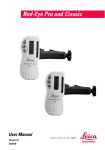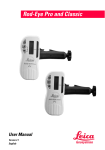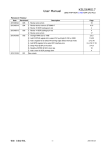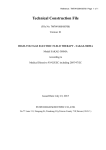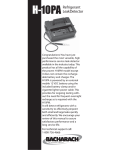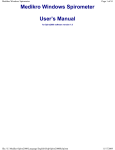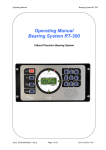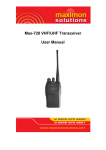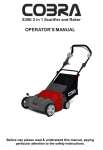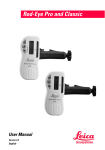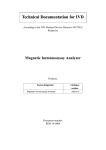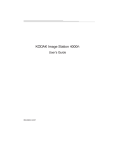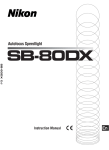Download M55042-1.0, Risk Management Summary, Medikro Spirometer System
Transcript
M55042-1.0 RISK MANAGEMENT SUMMARY REPORT: SpiroStar USB and SpiroStar DX Made by: KV 7.3.2008 Kimmo Vauhkonen Checked by: OP 7.3.2008 Olli Pohjolainen Accepted by: OP 7.3.2008 Olli Pohjolainen 1. Scope This Risk Management Summary Report specifies the systematic approach to evaluation of hazards associated with the Medikro SpiroStar USB and DX spirometers by identifying the intended use, device characteristics and hazards and estimating the risks associated with the device. Information from SpiroStar USB, SpiroStar DX, Disposable Flow Transducer and Spiro2000 Software Risk Management Files was used to complete this Risk Management Summary Report. 2. Methodology RISK LEVEL for each hazard is estimated. Design and testing solutions are then taken into account which reduce the hazard. The new RESIDUAL RISK LEVEL is then evaluated and if necessary, re-evaluated later based on the actual RESIDUAL RISK. Risk Management is made according to Medikro´s internal procedure M7421, Risk Management Procedure and in accordance with ISO 13485:2003 Risk Management Standard. 2.1 Propability levels 1. Almost Impossible, Zero propability of occurance 2. Remote, Unlike to occur, but possible 3. Occasional, likely to occur in sometime in the lifetime of the device 4. Probable, likely to occur several times in the lifetime of the device 5. Frequent, likely to occur often 2.2 Severity levels 1. Insignificant, not a safety risk 2. Minimum, causes annoyance to the user, not likely to cause any actual injury 3. Minor, may cause inconvenience, temperary injury possible 4. Medium, safety risk, injury possible, death unlikely 5. Major, significant safety hazard, death or serious injury possible 2.3 Risk level index 1…9 No preventive actions required 10…15 Preventive action required. Residual risk acceptance shall be made if the risk index stays in this level. >15 Untolerable risk 3. Intended use/purpose and identify characteristics (Step 1 from ISO 14971:2000, Annex A) 1. What is the intended use and how is the device to be used? 1.1 Intended use: Diagnostic spirometer A device that measures lung air volume and airflow rate for pulmonary disease diagnosis and screening. These measurements provide information about a patient's pulmonary function which may be compared with normal values or the patient's former values. The Medikro Spirometer is intended for use by or on the order of a physician in a hospital or clinical setting. 1.2 Intended user: Healthcare professionals with appropriate education, including medical doctors, nurses and occupational nurses. 1.3 Required skill and training of the user: Skills: Basic medical competence for making spirometry studies. Training: User Manual 1.4 Operational environment: 1.5 Who installs the device: - Operating temperature: +10…+40 C - Storage temperature: +10…+40 C - Relative atmospheric humidity: 5…85% - Barometric pressure: 600…1060 hPa Local IT support personell or end-user according to installation instructions provided by Medikro. 1.6 Can the patient influence the use of the device: Patient/subject can not use the device by himself/herself. 1.7 Users with special needs (like handicapped): The product is designated for use on both adult and pediatric patients. Normal values and comparative results are not calculated for children under the age of six. 2. Is the device intended to contact the patient or other persons? 2.1 Patient The disposable flow transducer is a single use component intended to have direct contact with the patient’s mucosal membranes within the mouth. Duration less than 30 minutes, typically a few minutes. Nose Clip has contact with patients skin (nose). Duration less than 30 minutes, typically a few minutes. 1(9) 2.2 Other persons Randon skin contacts with outer surfaces of disposable flow transducer, tubing, nose clip or device. 3. What materials and/or components are incorporated in the device or are used? 3.1 Are the characteristics relevant to safety known: Biocompatibility characteristics of the disposble flow transducer are identified (ISO 10993 testing, etc.). Material properties of random patient contact materials are identified (food contact approval statements, data sheets, etc). 4. Is energy delivered to and/or extracted from the patient? No. 5. Are substances delivered to and/or extracted from the patient? No. 6. Are biological materials processed by the device for subsequent re-use? No. 7. Is the device supplied sterile or intended to be sterilized by the user or are other microbiological controls applicable? No. Disposable flow transducer is a single-use instrument. 8. Is the medical device intended to be routinely cleaned and disinfected by the user? No. Disposable flow transducer is a single-use instrument. 9. Is the device intended to modify the patient environment? No. 10. Are measurements made? Yes. The list of measured and/or calculated variables is specified in User Manual and Design Documents. 11. Is the device interpretative? The spirometer gives a short interpretation from results. MD gives final diagnosis. 12. Is the device intended to control or to interact with other devices or drugs? Yes. Spirometer is connected to PC via serial or USB port and needs application software (Spiro2000). 13. Are there unwanted outputs of energy or substances? No. 14. Is the device susceptible to environmental influences? The environmental parameter ranges are: - Operating temperature: +10…+40 C - Storage temperature: +10…+40 C - Relative atmospheric humidity: 5…85% - Barometric pressure: 600…1060 hPa 15. Does the medical device influence the environment? No. 16. Essential disposable materials? Plastic Disposable Flow Transducer and Nose Clip. Spirometer Unit includes electronics. 17. Is maintenance and/or calibration necessary? Daily system calibration is recommended. 18. Does the device contain software? Yes, installed by the IT personell, end-user or the supplier. 19. The time limit for storage Two (2) years for the disposable flow transducer. 20. Possible delayed and/or long term use effects? Product is never used for extended time periods. 21. To what mechanical forces will the device be subjected? Disposable flow transducer connector with plastic tubing is linked, plastic tubing may be erroneously pressed, instrument is connected to PC serial/USB port. 22. What determines the lifetime of the device? The life cycle of the device is as long as the daily system calibration can be successfully completed and the verification gives the accuracy of +/- 3% of the volume. 23. Is the device intended for single use or re-use? Disposable flow transducer is single use. The device, excluding disposable flow transducer, is intended as re-usable device 2(9) 24. Is safe decommissioning or disposal of the device necessary? Single-used parts shall be disposed according to local regulations, usually with normal hospital waste. Device shall be disposed according to local regulations, in EU according to WEEE directive. 25. Does installation or use of the device require special training? Medical professionals should be able to use the device according to instructions provided by Medikro. 26. Will new manufacturing processes need to be established or introduced? Manufacturing and QA instructions to each component. 27. Is successful application of the device critically dependent on human factors such as the user interface? Software user interface is essential part of the use of the device. 28. Is the device intended to be mobile or portable? The device is stand-alone, but can be used with a laptop PC. 29. Essential performance identification Device shall meet ATS and ERS spirometry recommendations. 30. Critical components? Biocompatibility: Disposable Flow Transducer Measurement accuracy: Pressure sensor, Disposable Flow Transducer Electrical Safety: Not critical factor because patient is isolated even from the device unit and USB/Serial port via 2m plastic pressure tube. Though, device shall meet IEC/EN 60601 leakage current requirements and other requirements. 3(9) 4. Risk Management Process, ISO13485:2003, Steps 2-11 N/A, no heat risks 1.3 Mechanical force Leaks or compression of plastic tubing between disposable flow transducer and device may cause erroneus pressure signal and erroneous air flow signal. 1.4 Ionizing radiation N/A, no radiation risks 1.5 Non-ionizing radiation N/A, no radiation risks 1.6 Electromagnetic fields N/A, no EMF production 1.7 Moving parts N/A, no moving parts 1.8 Suspended masses N/A, no suspended masses 1.9 Patient support device failure N/A, not a patient support device 1.10 Pressure (vessel rupture) N/A 1.11 Acoustic pressure N/A, no effects on acustic pressure 1.12 Vibration N/A, no effects on vibration Does not produce vibration 1.13 Magnetic fields (e.g. MRI) N/A, not intended for use in external magnetic fields. Does not produce magnetic fields. 2. BIOLOGICAL HAZARDS 2.1 Bio-burden PXS 1.2 Heat SEVERITY Minor electrical shock, temperary pain: Not likely even in fault conditions. 2 2 4 Safety testing Patient safety test Reports according to IEC/EN 60601-1 2 1 2 3 2 6 User instructions User instructions (Installation instructions) 2 2 4 PXS POTENTIAL HARM PROBABILITY 1. ENERGY HAZARDS 1.1 Electricity SEVERITY RISK TYPE RESIDUAL RISK LEVEL PROBABILITY INITIAL RISK LEVEL PREVENTIVE ACTIONS PREVENTIVE ACTION DOCUMENTS AND RECORDS N/A. Parts not sterilized nor intended for sterilization 2.2 Bio-contamination Infection risk is minimized with the use of Disposable (Single Use) Flow Transducer. 3 3 9 Medikro Spirometer uses a single use Flow Sensor and is labeled as such. Flow Transducer Safety Instructions and product labels 2 2 4 2.3 Bio-incompatibility Skin or mucosa irritation/allergy is minimized by biocompatibility evaluation. 3 3 9 Use of tested materials Material certificates Biocompatibility Test Results 2 1 2 2.4 Incorrect output (substance/energy) N/A, device does not produce substances or energy 2.5 Incorrect formulation (chemical composition) N/A, use of tested materials 2.6 Toxicity Skin or mucosa irritation/allergy is minimized by biocompatibility evaluation. 2 2 4 Use of tested materials Material certificates Biocompatibility Test Results 1 1 1 2.7 Allergenicity Skin or mucosa irritation/allergy is minimized by biocompatibility evaluation. 2 3 6 Use of tested materials Material certificates Biocompatibility Test Results 1 2 2 2.7 (Cross-) Infection Infection risk is minimized with the use of Disposable (Single Use) Flow Transducer. 3 3 9 Medikro Spirometer uses a single use Flow Sensor and is labeled as such. Flow Transducer Safety Instructions and product labels 2 2 4 2.8 Pyrogenicity N/A 2.9 Inability to maintain hygienic safety Infection risk is minimized with the use of Disposable (Single Use) Flow Transducer. 2 2 4 Medikro Spirometer uses a single use Flow Sensor and is labeled as such. Flow Transducer Safety Instructions and product labels 1 2 2 2.10 Degradation Risk is minimized by recommended daily calibration with Calibration 3 1 3 Daily calibration User Manual, Quick Instructions 2 1 2 4(9) 3.2 Inadequate supply of power or coolant PXS 3 3 9 EN/IEC 60601-1-2 EMC compatibilty EN/IEC 60601-1-2 EMC Test Report 2 2 4 PXS SEVERITY Device malfunction or interference is minimized by EMC testing. PROBABILITY 3. ENVIRONMENTAL HAZARDS 3.1 Electromagnetic interference POTENTIAL HARM SEVERITY RISK TYPE RESIDUAL RISK LEVEL PROBABILITY INITIAL RISK LEVEL PREVENTIVE ACTIONS PREVENTIVE ACTION DOCUMENTS AND RECORDS N/A. If the device do not get power it does not work. No need for cooling. 3.3 Restriction of cooling N/A. No need for cooling. 3.4 Likelihood of operation outside prescribed environmental conditions Device malfunction may be present only in extreme environmental conditions. Even in those conditions there is not foreaseeable risks for patient health. 2 2 4 Safety Test Report EN60601-1 2 2 4 3.5 Incompatibility with other devices Does not work with older PC. 3 1 3 Technical Specifications Technical Specifications 2 1 2 3.6 Accidental mechanical damage Device malfunction, the false operation is very likely obvious: device simply stops working. 2 1 1 Mechanical structure stable Safety Test Report EN60601-1 2 1 1 3.7 Accidental electronic damage Device malfunction, the false operation is very likely obvious. 2 1 1 Safety Test Report EN60601-1 2 1 1 3.8 Contamination due to waste products and/or device disposal N/A Device is used wrongly. 3 2 6 A comprehensive Operator Help User Instructions System (User Manual) and Quick Labelling Reference Cards are supplied with each system. Equipment is used in hospitals and physicians offices where specialists or professionals are familiar with common Spirometry principles and similar medical equipment. Flow Transducers are lot coded and the use is instructed. 2 2 4 5.2 Inadequate operating instructions Device is used wrongly. 3 2 6 A comprehensive Operator Help User Instructions System (User Manual) and Quick Reference Cards are supplied with each system. Equipment is used in hospitals and physicians offices where specialists or professionals are familiar with common Spirometry principles and similar medical equipment. 2 2 4 5.3 Inadequate specification of accessories Device is used wrongly. 3 2 6 A comprehensive Operator Help User Instructions System (User Manual) and Quick Labelling Reference Cards are supplied with each system. Equipment is used in hospitals and physicians offices where specialists or professionals are familiar with common Spirometry principles and similar medical equipment. Flow Transducers are lot coded and the use is instructed. 2 2 4 4. HAZARDS RESULTING FROM INCORRECT OUTPUT OF ENERGY AND SUBSTANCES N/A, Device does not output energy 4.1 Electricity 4.2 Radiation 4.3 Volume 4.4 Pressure 4.5 Supply of medical gases 4.6 Supply of anaesthetic agents 5. HAZARDS RELATED TO USE OF THE DEVICE 5.1 Inadequate labelling 5(9) 2 5.5 Over-complicated operating instructions Device is used wrongly. 3 2 5.6 Unavailable or separated operating instructions Device is used wrongly. 3 5.7 Use by unskilled/untrained personnel Device is used wrongly. 5.8 Reasonably foreseeable misuse Device is used wrongly. 5.9 Insufficient warning of side effects N/A. System does not provide or administer any energy to patients. 6(9) PXS 3 5.10 Inadequate warning of hazards likely with re- Disposable Flow Transducer is reused. use of single use devices SEVERITY Device is used wrongly: - No volume calibration - Wrong Linearization File POTENTIAL HARM PROBABILITY SEVERITY 5.4 Inadequate specification of pre-use checks RISK TYPE RESIDUAL RISK LEVEL 2 2 4 6 A comprehensive Operator Help User Instructions System (User Manual) and Quick Reference Cards are supplied with each system. Equipment is used in hospitals and physicians offices where specialists or professionals are familiar with common Spirometry principles and similar medical equipment. 2 2 4 2 6 A comprehensive Operator Help User Instructions System (User Manual) and Quick Reference Cards are supplied with each system. Equipment is used in hospitals and physicians offices where specialists or professionals are familiar with common Spirometry principles and similar medical equipment. 2 2 4 2 2 4 A comprehensive Operator Help User Instructions System (User Manual) and Quick Reference Cards are supplied with each system. Equipment is used in hospitals and physicians offices where specialists or professionals are familiar with common Spirometry principles and similar medical equipment. 2 2 4 2 2 4 System does not pose any harm. User Instructions Professionals or specialists review results. 2 2 4 3 3 9 Flow Transducers are labelled User Instructions as Disposable and attached Labelling documentation includes all necessary warnings. Equipment is used in hospitals and physicians offices where specialists or professionals are familiar with common Spirometry principles and similar medical equipment. 1 3 3 PXS PROBABILITY INITIAL RISK LEVEL PREVENTIVE ACTIONS 6 A comprehensive Operator Help System (User Manual) and Quick Reference Cards are supplied with each system. Equipment is used in hospitals and physicians offices where specialists or professionals are familiar with common Spirometry principles and similar medical equipment. Flow Transducers are lot coded and the use is instructed. PREVENTIVE ACTION DOCUMENTS AND RECORDS User Instructions Labelling PXS 2 PXS 3 PREVENTIVE PREVENTIVE ACTION ACTIONS DOCUMENTS AND RECORDS 6 A comprehensive Operator Help User Instructions System (User Manual) and Quick Reference Cards are supplied with each system. Equipment is used in hospitals and physicians offices where specialists or professionals are familiar with common Spirometry principles and similar medical equipment. SEVERITY Erroneous results RESIDUAL RISK LEVEL PROBABILITY 5.11 Incorrect measurement and other metrological aspects POTENTIAL HARM SEVERITY RISK TYPE PROBABILITY INITIAL RISK LEVEL 2 2 4 Professionals or specialists review results. 5.12 Incorrect diagnosis Errorneus diagnosis 2 3 6 User Manual and diagnosis by MD. System does not provide direct diagnostic to user. User Instructions 1 3 3 5.13 Erroneous data transfer Data lost 3 3 6 Operator Help System advises User Instructions the medical technician to re-load the information. 2 2 4 5.14 Mispresentation of results System does not provide direct diagnostic statements. Physician, professional or specialist review required. 2 2 4 User Manual and diagnosis by MD 2 2 4 Not functioning in all PCs. Not a safety issue. 3 1 3 Minimum HW specifications and Minimum specfications in product testing. brochures and User Instructions. 2 1 2 Not functioning in DOS and older Windows. Not a safety issue. 3 1 3 OS specifications and product testing 2 1 2 2 2 2 2 4 2 2 4 Spirometry systems are one of User Instructions several different types of Spirometry diagnostic tools used in hospitals and physician offices. Equipment is used in hospitals and physicians offices where specialists or professionals are familiar with common Spirometry principles and similar medical equipment. 2 2 4 2 2 4 Daily volume calibration (ERS&ATS recommendations) 2 2 4 User Instructions 5.15 Incompatibility with consumables/laccessories/other devices - PC hardware (HW) compatibility (processor speed, RAM size, serial or USB port, display resolution) - Operating system (OS) compatibility 6. INAPPROPRIATE, INADEQUATE OR OVER-COMPLICATED USER INTERFACE 6.1 Mistakes and judgement errors 6.2 Lapses and cognitive recall errors 6.3 Slips and blunders (mental or physical) 6.4 Violation or abbreviation of instructions, procedures, etc. 6.5 Complex or confusing control system 6.6 Ambiguous or unclear device state 6.7 Ambiguous or unclear presentation of settings, measurements or other information 6.8 Misrepresentation of results 6.9 Insufficient visibility, audibility or tactility 6.10 Poor mapping of control to action, or of displayed information to actual state 6.11 Controversial modes or mappings as compared to existing equipment 7. HAZARDS ARISING FROM FUNCTIONAL FAILURE, MAINTENANCE AND AGEING Erroneous treatment of patients 7.1 Inadequacy of performance characteristics for the intended use Daily volume calibration is ERS/ATS 7.2 Lack of, or inadequate specification for maintenance including inadequate specification recommendation. of post maintenance functional checks If this is not done the risk for measurement accuracy problems slightly increases, but is still very small. Spirometry systems are one of several different types of Spirometry diagnostic tools used in hospitals and physician offices. Equipment is used in hospitals and physicians offices where specialists or professionals are familiar with common Spirometry principles and similar medical equipment. Spirometry systems are one of several different types of Spirometry diagnostic tools used in hospitals and physician offices. Equipment is used in hospitals and physicians offices where specialists or professionals are familiar with common Spirometry principles and similar medical equipment. 7(9) Minimum specfications in brochures and User Instructions. Technical Manual and User Instructions If this is not done the risk for measurement accuracy problems slightly increases, but is still very small. PREVENTIVE ACTION DOCUMENTS AND RECORDS Technical Manual and User Instructions PXS 2 PXS 2 PREVENTIVE ACTIONS 4 Daily volume calibration (ERS&ATS recommendations) SEVERITY Daily volume calibration is ERS/ATS recommendation. RESIDUAL RISK LEVEL PROBABILITY 7.3 Inadequate maintenance POTENTIAL HARM SEVERITY RISK TYPE PROBABILITY INITIAL RISK LEVEL 2 2 4 Spirometry systems are one of several different types of Spirometry diagnostic tools used in hospitals and physician offices. Equipment is used in hospitals and physicians offices where specialists or professionals are familiar with common Spirometry principles and similar medical equipment. (ERS&ATS recommendations) 7.4 Lack of adequate determination of end of device life Device life is estimated to be 5 years. 2 2 4 The life cycle of the device is as Technical Manual and User long as the daily volume Instructions calibration can be successfully completed and the verification gives the accuracy of +/- 3% of the volume. 2 2 4 7.5 Loss of mechanical integrity No foreaseeable danger to the operator or patient. 2 1 2 Device meet safety standards. Safety Test Report EN60601-1 2 1 2 2 2 4 Proper packing Packing instructions and specifications 2 2 4 The Medikro Flow Transducer is a single use device. 2 3 6 Instructions are provided, User Instructions additionally tha equipment is used in hospitals and physicians offices where specialists or professionals are familiar with common hygiene and spirometry principles and similar medical equipment. 1 2 3 8.1 SW installation not properly completed Application software does not function. No safety risks. 3 1 3 Instructions Installation instructions. 2 1 2 8.2 SW failures, bugs Device doesn’t operate as specified, the program collaps, etc. 4 2 8 Software verification and validation testing Software validation, verification and test reports. 3 2 6 8.3 Database use Wrong data entry to database Use of wrong ID number from database Exit from application software before database update is completed Database corruption 3 2 6 Software verification and validation testing Software validation, verification and test reports. 2 2 4 8.4 Operator faults Wrong deletion of patient data Wrong deletion of signal data Patient study using wrong ID data Wrong linearization file Wrong environmental settings 3 2 4 Modifications need operator confirmation User Instructions 2 2 4 7.6 Inadequate packaging (contamination and/or The device will be shipped in adequate packaging to ensure arrival deterioration of the device) at the user destination in good condition. 7.7 Improper re-use 8. OTHER SOFTWARE RISKS User manual instructions User Responsibility 5. Conclusion The operation of the Medikro Spirometer, its design and development, its operating software, specifications, coding, testing, and operator manual have been carefully analyzed to identify the hazards associated with their use. Medikro 's overall document control and Engineering Development procedures have also been reviewed. In all situations, it has been concluded that appropriate measures have been taken to address all identified potential hazards associated with each of these components of the Medikro Spirometer System and it's use. 8(9) Version history Version 1.0 Date 7.3.2008 Changes ( what, why) Information from SpiroStar USB, SpiroStar DX, Disposable Flow Transducer and Spiro2000 Software Risk Management Files was used to complete this Risk Management Summary Report. 9(9)









